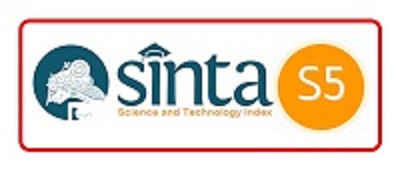Pengaruh ROA, Proporsi Dewan Komisaris Independen, ACHANGE, LEV, DCHANGE Terhadap Tax Avoidance
DOI:
https://doi.org/10.29240/disclosure.v4i1.9656Keywords:
Tax Avoidance, Pentagon Fraud, External Pressure, Financial StabilityAbstract
The background to this research focuses on several companies that carry out deliberate tax avoidance actions such as not remitting taxes that have been collected by not submitting Tax Returns (SPT). Tax avoidance or tax avoidance is an activity to reduce or eliminate tax debts that should be paid by the company by not violating existing laws. This study aims to detect whether there is a significant relationship between the independent variables in detecting tax avoidance in trading industry companies listed on the Indonesia Stock Exchange during the 2017-2021 period. This study uses a quantitative approach with sample data obtained from annual reports of trading industry companies that have been published on the Indonesia Stock Exchange during the 2017-2021 period. The sample selection technique used was purposive sampling, and data was obtained from 30 samples. The method used is descriptive statistical analysis and multiple regression analysis. The results of this study indicate that the variables Return On Assets (ROA) and Pressure from Outside (LEV) have positive and significant results on tax avoidance. Other factors which include the Proportion of Independent Commissioners, Financial Stability (ACHANGE), and Change of Directors (DCHANGE) do not have a significant effect on tax avoidance.
Downloads
References
Arif, I., & Rawat, A. S. (2018). Corruption, Governance, and Tax Revenue: Evidence from Eagle Countries. Journal of Transnational Managementof Transnational Management, 23(2-3), 119–133.
Atwood, T. J., & Lewellen, C. (2019). The Complementarity between Tax Avoidance and Manager Diversion: Evidence from Tax Haven Firms. Contemporary Accounting Research, 36(1), 259–294.
Avery, S. (2020). For Fraud, Look under ‘Serious and Organized Crime. Public Money & Management, 40(5), 407–414.
Bao, Y., Ke, B., Li, B., Yu, Y. J., & Z., & J. (2020). Detecting Accounting Fraud in Publicly Traded U.S. Firms Using a Machine Learning Approach. Journal of Accounting Research, 58(1) 99-2, 199–235.
Castañeda, V. M. (2021). Tax Equity and its Association with Fiscal Morale. International Public Management Journal, 24(5), 710–735.
Hermawan, A., & N. (2021). The Effect of Governance, Risk Management, and Compliance on Efforts to Minimize Po- tential Fraud Based on the Fraud Penta- gon Concept. Asia Pacific Fraud Journal, 6(1), 82–95.
Hidayah, N. E. F., & R. (2018). Manfaat Laba untuk Menambah Utang dan Mengurangi Pajak. Jurnal Akuntansi Multiparadigma, 10(2), 262–275.
Hindriks, J., & Nishimura, Y. (2021). Taxing Multinationals: The Scope for Enforcement Cooperation. Journal of Public Economic Theory, 23(3), 487–509.
Murphy, R. (2019). Corporate Tax Avoidance: Is Tax Transparency the Solution? A Practitioner View. Accounting, 49(5), 584–586.
Pamungkas, I. D., & Utomo, S. D. (2018). Fraudulent Financial Reporting: An Application of Fraud Pentagon Theory to Association of Southeast Asian Nations Corporate Governance Scorecard. Journal of Advanced Research in Law and Economics, 9(5), 1729–1737.
Pradipta, A. (2019). Pengaruh Roa , Leverage , Komite Audit , Size , Sales Growth Terhadap Tax Avoidance. Jurnal Bisnis Dan Akuntansi, 21(1), 1–8.
Puspita A.F, & D. P. (2021). ApakahTeori Fraud Pentagon Relevan Dalam Mendeteksi Penggelapan Pajak. Jurnal Akuntansi Multiparadigma, 531–546.
Rahmayani, M. W., Riyadi, W., & Ginanjar, Y. (2021). Pengaruh Return On Assets , Debt To Equity Ratio , Proporsi Dewan Komisaris Independen dan Ukuran Perusahaan Terhadap Tax Avoidance. Jurnal Ilmiah Manajemen, XII(1), 119–130.
Ramadhan, D. (2020). Root Cause Analysis Using Fraud Pentagon Theory Approach (A Conceptual Framework). Asia Pacific Fraud Journal, 5(1), 118–125.
Salehi, M., & Salami, S. (2020). Corporate Tax Aggression and Debt in Iran. Journal of Islamic Accounting and Business Research, 11 (1), 257–271.
Septriyani, Y., & Handayani, D. (2018). Mendeteksi Kecurangan Laporan Keuangan dengan Analisis Fraud Pentagon. Jurnal Akuntansi, Keuangan Dan Bisnis, 11(1), 11–23.
Sugiyono. (2019). Metode Penelitian Kuantitatif, Kualitatif, dan R&D. Alfabeta.
Triyanti N.W., & Kartika H. T., R. R. D. (2020). Pengaruh Profitabilitas, Size, Leverage, Komite Audit, Komisaris Independen dan Umur Perusahaan terhadap Tax Avoidance. Jurnal Ilmiah Universitas Batanghari Jambi, 20(1), 113–120.
Uly Y.A. (2022). Direktur Perusahaan Jasa “Security†Diduga Mengemplang Pajak, Negara Rugi Rp 26,9 Miliar. Kompas.Com. https://money.kompas.com/read/2022/10/27/211500226/direktur-perusahaan-jasa-security-diduga-mengemplang-pajak-negara-rugi-rp-26-9?page=all %0A%0A
indohoki77 menawarkan pengalaman bermain yang tak terlupakan. Jadi, tunggu apa lagi? Segera daftarkan diri Anda
Utami, S., S. (2021). Pengaruh ROA, Leverage dan Ukuran Perusahaan Terhadap Tax avoidance Pada Perusahaan Sub-Sektor Otomotif dan Komponen Di BEI Periode Tahun 2012-2018. Jurnal Akuntansi, Perpajakan, Dan Auditing, 2(1), 73–88.
Wardani, D. K., & Susilowati, W. T. (2020). Urgensi Transparansi Informasi dalam Perlawanan Pajak. Jurnal Akuntansi Multiparadigma, 11(1), 127–137.
Downloads
Published
How to Cite
Issue
Section
Citation Check
License
Copyright (c) 2024 Hesti Rahayu, Ulriche Suci Cahyani, Gilbert Pius Valeriyan, Imelda Sinaga, Agnes Susana Merry Purwati

This work is licensed under a Creative Commons Attribution-ShareAlike 4.0 International License.
Authors who publish with this journal agree to the following terms:
- Authors retain copyright and grant the journal right of first publication with the work simultaneously licensed under a Creative Commons Attribution License (CC BY-NC-SA 4.0) that allows others to share the work with an acknowledgment of the work's authorship and initial publication in this journal.
- Authors are able to enter into separate, additional contractual arrangements for the non-exclusive distribution of the journal's published version of the work (e.g., post it to an institutional repository or publish it in a book), with an acknowledgment of its initial publication in this journal.
- Authors are permitted and encouraged to post their work online (e.g., in institutional repositories or on their website) prior to and during the submission process, as it can lead to productive exchanges, as well as earlier and greater citation of published work (See The Effect of Open Access).














